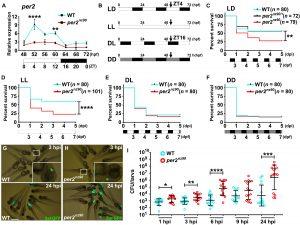Neutrophils are the most abundant immune cells in humans and play a crucial role in defending against bacterial infections. They are known for their rapid response, quickly migrating to infection sites to neutralize invading pathogens.
Circadian rhythms are found in most cell types and serve to synchronize physiological processes with the external environment. Among the various environmental cues, light is the most potent signal for resetting these internal clocks.
New research reveals that the immune system follows a daily rhythm, with heightened activity during the day (Figure 1). The study sheds light on how our body’s internal clock, or circadian rhythm, regulates immune responses—particularly through the actions of neutrophils, a frontline class of white blood cells.

Figure 1: Per2 deficiency enhances susceptibility to bacterial infection. (A) Expression of per2 in whole WT and per2nz90 larvae from 48 to 72 hpf under LD conditions (qRT-PCR, n = 20 larvae per sample in experimental triplicate, normalized to lowest time point). (B) Schematic illustrating lighting conditions for infection experiments in (C) to (F), LD, LL, reversed DL, and DD, infected with Salmonella at 52 hpf (ZT4 and ZT16 under LD and DL conditions, respectively). (C to F) Kaplan-Meier graphs of WT, per2nz90/+ [(C) only] and per2nz90 larvae under the LD (C), LL (D), DL (E), and DD (F) conditions. (G and H) Live imaging of infected WT (G) and per2nz90 (H) larvae at 3 and 24 hpi with Sal-GFP (LD condition). Insets: Magnified views of boxed regions. Scale bar, 500 μm. (I) Bacterial burdens within WT and per2nz90 larvae at 1, 3, 6, 9, and 24 hpi with Sal-GFP (LD condition). Data in (C) to (F) collected from three independent experiments per sample. Error bars denote means ± SD. *P < 0.05, **P < 0.01, ***P < 0.001, and ****P < 0.0001; two-way ANOVA with Bonferroni’s post test (A), Gehan-Breslow-Wilcoxon test [(C) to (F)], or unpaired Student’s t test (I). dpi, days post infection.
To investigate how these cells align their activity with the day-night cycle, the research team used zebrafish as a model. These small, transparent freshwater fish are genetically similar to humans and allow researchers to visually track cellular behaviour in real time.
Previous observations had indicated that immune activity in zebrafish peaked during the early part of the day—their active period. This suggests an evolutionary adaptation: during the day, organisms are more exposed to pathogens, and a heightened immune state provides better protection.
To uncover the mechanism behind this time-dependent immune response, the team focused on the circadian clock within neutrophils themselves. The study demonstrated that neutrophils contain an intrinsic biological clock that responds to light cues and enhances their antibacterial function during daylight hours.
Given that neutrophils are first responders during infection and inflammation, this discovery could have wide-reaching therapeutic implications. By targeting the circadian mechanisms in neutrophils, future treatments may be able to boost immune responses in diseases characterized by inflammation or recurrent infection.
Journal article: Yi Du, L., et al. 2025. A light-regulated circadian timer optimizes neutrophil bactericidal activity to boost daytime immunity. Science Immunology.
Summary by Stefan Botha










